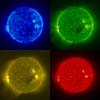 |
Washington DC (SPX) Feb 08, 2007 Less than one hundred years ago, the south pole of Earth was a land of utter mystery. Explorers labored mightily to get there, fighting scurvy, wind, disorientation and a fantastic almost-martian cold. Until Roald Amundsen and Robert F. Scott reached the Pole in 1911 and 1912, it was terra incognita. The situation is much the same today-on the sun. "The sun's south pole is uncharted territory," says solar physicist Arik Posner of NASA headquarters. "We can barely see it from Earth, and most of our sun-studying spacecraft are stationed over the sun's equator with a poor view of higher latitudes." There is, however, one spacecraft that can travel over the sun's poles: Ulysses, a joint mission of NASA and the European Space Agency. And today Ulysses is making a rare South Pole flyby. "On February 7th, the spacecraft reaches a maximum heliographic latitude of 80oS-almost directly above the South Pole," says Posner who is the Ulysses Program Scientist for NASA. Solar physicists are thrilled. Ulysses has flown over the sun's poles only twice before--in 1994-95 and 2000-01. The flybys were brief, but enough to prove that the poles are strange and interesting places.
Consider the following: 1. The sun's north magnetic north pole sticks out the south end of the sun. Magnetically, the sun is upside down! "Most people don't know it, but we have the same situation here on Earth," notes Posner. "Our magnetic north pole sticks out of the geographic south pole." Magnetically, Earth and sun have a lot in common. "Both the sun's and Earth's magnetic poles are constantly on the move, and they occasionally do a complete flip, with N and S changing places." This flipping happens every 11 years on the sun in synch with the sunspot cycle. It happens every 300,000 years or so on Earth in synch with--what? No one knows. "Studying the polar magnetic field of the sun might give us some clues about the magnetic field of our own planet." 2. There are holes over the sun's poles--"coronal holes." These are places where the sun's magnetic field opens up and allows solar wind to escape. "Flying over the sun's poles, you get slapped in the face by a hot, million mph stream of protons and electrons," he says. Ulysses is experiencing and studying this polar wind right now. (Note: Earth has a polar hole, too--the ozone hole. The chemistry of the ozone hole is totally unrelated to the magneto-physics of coronal holes, but says Posner, "it is interesting that so many poles seem to have holes.") 3. Just as the sun's polar magnetic field allows solar wind out, it also allows galactic cosmic rays in. Could the space above the sun's poles be a place where we can sample interstellar matter without actually leaving the solar system? "That's what we thought before our first polar flyby in 1994," recalls Posner. "But we were wrong. Something is keeping cosmic rays out of the sun's polar regions. The current flyby gives us a chance to investigate this phenomenon." 4. Another mystery: There is evidence from earlier flybys that the north pole and the south pole of the sun have different temperatures. "We're not sure why this should be," says Posner, "and we're anxious to learn if it is still the case." Today's south polar flyby will be followed by a north polar flyby in early 2008, allowing a direct north vs. south comparison. In a sense, Ulysses is more like Richard E. Byrd than Amundsen or Scott. In November 1929, Byrd flew over Earth's south pole in a Ford Trimotor airplane named the Floyd Bennett. The plane barely gained enough altitude to overfly the high polar plateau, clearing some mountain peaks and glaciers by little more than a few hundred feet. Compasses were useless for direction-finding so close to the magnetic pole, and there were few landmarks in the white expanse below. Nevertheless, he managed to guide the plane straight to latitude 90 S. Like Byrd, Ulysses is a flier. "Today the spacecraft is gliding 300 million km (2 AU) above the sun's 'Antarctic.' That's a safe distance and a good place to sample the sun's polar winds and magnetic fields." In the long run, however, Ulysses will follow Scott: "Had we lived I should have had a tale to tell of hardihood, endurance and courage...," Scott wrote shortly before his entire party perished from cold. They reached the pole, famously chasing Amundsen, but never made it home again. Ulysses will never come home either, eventually perishing in the cold of space when its internal power sources fail. (For more on this, see Science@NASA's "Cold Peril"). To honor the common heritage of exploration, NASA's Science Mission Directorate dedicates its efforts during the Ulysses' South Pole flyby to Roald Amundsen, Robert F. Scott and Richard E. Byrd. Amundsen, Scott, Byrd, and now Ulysses. Says Posner, "their stories will inspire generations to come." Related Links The International Heliophysical Year Solar Science News at SpaceDaily
 Greenbelt MD (SPX) Jan 25, 2007
Greenbelt MD (SPX) Jan 25, 2007NASA's twin STEREO (Solar Terrestrial Relations Observatory) spacecraft, built and operated by the Johns Hopkins University Applied Physics Laboratory (APL), in Laurel, Md., completed a series of complex maneuvers yesterday to position the spacecraft in their mission orbits. The spacecraft will be in position to produce the first 3-D images of the sun by April. |
|
| The content herein, unless otherwise known to be public domain, are Copyright Space.TV Corporation. AFP and UPI Wire Stories are copyright Agence France-Presse and United Press International. ESA Portal Reports are copyright European Space Agency. All NASA sourced material is public domain. Additional copyrights may apply in whole or part to other bona fide parties. Advertising does not imply endorsement, agreement or approval of any opinions, statements or information provided by Space.TV Corp on any Web page published or hosted by Space.TV Corp. Privacy Statement |